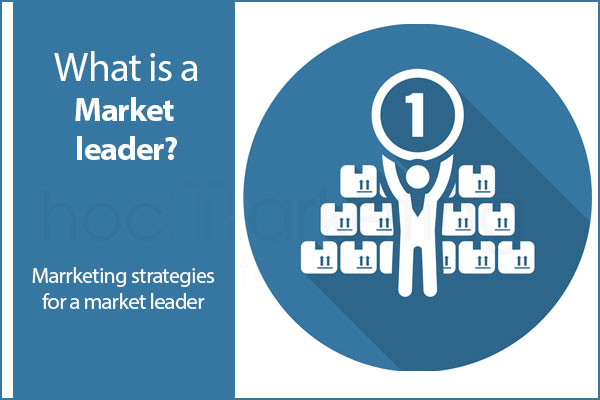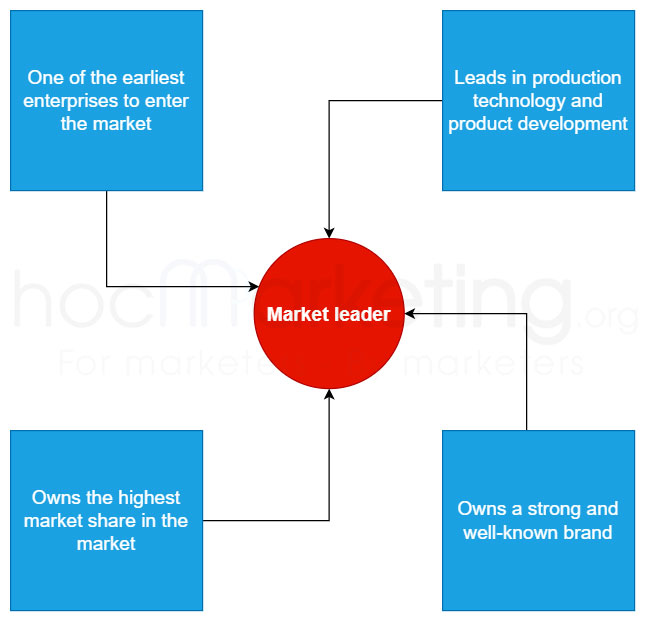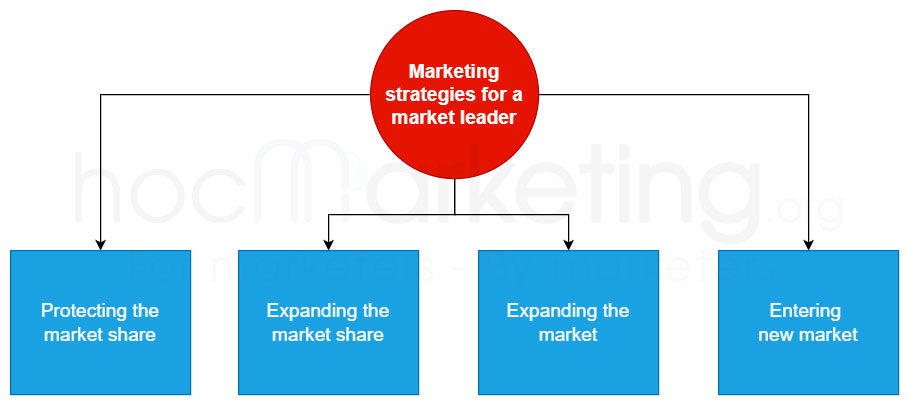
What is a market leader? Strategies for a market leader

Market leaders are brands which have successfully established themselves in the market through their marketing strategies, such as creating compelling messages and building strong connections with consumers. In this article, we will discuss the definition of a market leader and marketing competitive strategies.
Any business wants to rise to the top of the market and take the lead in introducing new products, changing prices, establishing distribution and promotions. Are these businesses a Market leader? What "qualities" should a market leader have? And by what strategy can a business maintain its leading position? In this article, we will discuss the definition of a market leader and marketing competitive strategies.
What is a market leader?
A market leader is a company or brand which has established itself as the most popular or successful product in its specific field. This position is achieved by leading the market in terms of market share, sales and marketing investment, either through spending more money on advertising and promotions to consumers, or by offering a unique value proposition that makes it stand out from other competitors.
For example:
In America, the Coca Cola brand is a market leader in the soft drink industry, as it controls an estimated 80% of the American soda market and spends around $2 billion each year promoting its products.
In Canada, the Tim Horton's brand is a market leader in the coffee and doughnut industry, as it controls an estimated 60% of this specific industry.
In China, the Huawei brand is a market leader in the mobile phone industry, as it has 42% of the Chinese market share.
In South Korea, the Samsung brand is a market leader in the TV and smartphone industries, as it controls an estimated 70% of each specific industry.
What factors make a company become a market leader?
What are the criteria of a market leader? And how to know if a business is holding the position of market leader or not? Here are basic factors that flead a company or brand to become a market leader:
1. Market leader is one of the earliest enterprises to enter the market
This is the most basic factor that can help a business become a market leader. If a pioneer company offers a completely new product/service to the market, it is definitely a market leader. However, the product/service must ensure novelty to attract a large number of customers and maintain its dominance in the market. For example, Red Bull was the first enterprise to exploit the "energy drink" production market and develop the market to this day.
2. Market leader leads in production technology and product development
Market leader is not only the one who leads the trend of using new products/services, but also is an enterprise that invests heavily in market research, product development and application of leading production technology. This is also a way for the company to affirm its leading position in all aspects to convince customers of the superiority of the brand.
3. Market leader owns a strong and well-known brand
A strong brand is the name that always comes first in the mind of the customer. This is a testament to the success of the business when it receives a positive response from a large number of customers and the community. When a brand becomes a market leader, it means that the brand has created its own identity and shines in the market thanks to the preeminent values it brings. Therefore, the stronger the brand, the stronger the leading position of the business.
4. Market leader owns the highest market share in the market
Market share is also a factor that determines the market dominance of a business. If the company accumulates the highest market share, the position of market leader will belong to that company. Maybe it is a business that entered the market the earliest, has the time to exploit the market and accumulate the highest market share. But also, it's a market leader from the market challenger.
Competitive strategies for a market leader
Marketing strategies are the foundation for success in any competitive market. The success of a brand is often measured by the amount of revenue generated, its market share and how well it competes for consumer attention against its competitors. Market leaders have an advantage over other brands, because they enjoy higher market share and more recognition among consumers. However, this doesn't mean they are invincible, and their market position needs to be protected.
Market leaders often rely on one of the following competitive strategies in order to maintain their leadership status: Protecting the market share, Expanding the market share, Expanding the total market.
1. Protecting the market share
A market leader's first priority is to maintain its current market position by protecting it from competitors (market challengers & market followers). In order to do so, a company must make sure that it does not lose any customer loyalty and builds a strong brand image in the eyes of consumers. Market leaders can use certain competitive tatics such as:
- Product improvement: By improving the quality of one or more of its products, a market leader can take advantage of the customers that are loyal to their brand and convince them to stick with it.
- Price reductions: By reducing the price of one or more of its products or services, a market leader can not only attract new customers to their brand, but also try to convince other consumers who are loyal to competitors to switch to their product.
- Promotions: By offering discounts, free samples and special offers, a company is able to increase the demand for one or more of its products or services.
- Customer support & service improvement: By improving a customer's purchasing experience, a company can keep them from switching to competitors. With a strong relationships with customers, a company can reduce the level of customer complaints and therefore prevent its market share from being affected by competitors.
For example, the leading online search engine and web portal in China, Baidu, has maintained its leadership position in the Chinese market for many years. In order to protect their strong market share from potential competitors such as Tencent & Sina, Baidu has been able to continuously improve their product through innovative strategies such as self-developed applications (e.g. Baidu PC Faster) and services, as well as providing customer support to maintain strong relationships with its customers.
2. Expanding the market share
Once a company is able to protect its market share, it can then focus on expanding the total market. The goal here for a market leader is to increase its brand awareness among consumers and try to become the leader in secondary product or service markets. Market leaders can use several competitive tatics such as:
- Product diversification: A company might diversify its offering to include new products or services. For example, Coca-Cola has expanded its product line to include orange juice and other non-carbonated beverages in addition to its original soft drink.
- Geographic expansion: A brand might enter foreign markets by selling some of its products overseas. For example, the American company General Electric has been successful in expanding its products & services internationally.
- Channel expansion: A company might expand the number of channels through which it distributes products or services to consumers. For example, Disney has expanded from a traditional movie studio producing movies and TV shows to a multi-media conglomerate that is now present on social media, web portals and theme parks.
3. Expanding the market
The total demand of a market can increase thank to environmental factors (natutal, economic, technological, policial, social) or the stimulation from the company. Market leaders can expand the market by developing new users, new uses, and more usage of its products.
For example, traditionally boy-focused LEGOs—the world’s biggest toymaker—now successfully targets girls. Based on extensive research into differences between how boys and girls play, in 2011 the company introduced the LEGO Friends line for girls. The line features pastel color bricks and construction sets that encourage girls to build everything from Olivia’s House or Emma’s Pet Salon to Andrea’s City Park Café. LEGO Friends has become one of the most successful lines in LEGO history, helping to triple LEGO’s sales to girls within only one year. Last year alone, sales of the Friends line were up 30 percent over the previous year.
Sometimes, marketers can expand markets by discovering and promoting new uses for the product.
For example, digital cameras were introduced in the late 1990s and at first only appealed to consumers with a tech interest, who were attracted by the novelty of this new technology. But as more people bought them and discovered the ease of use for this product, sales began to increase dramatically. At first, digital cameras were only used in a similar way as conventional cameras: they let you take photos and instantly see if it was properly exposed. However, as time went on, they became more than just a substitute for conventional cameras; marketers also discovered new uses with the help of consumers, such as taking photos and instantly sharing them on social media or collaborating with colleagues via email.
4. Entering new market
The market leader can strengthen his position as the market expands further. When a business chooses when to enter a new market depends on the position of the product in its life cycle. Usually, this strategy is used when the product is in a mature stage.
Businesses can find new markets through 3 groups:
- New customer group: Enterprises enter a completely new market, reach new customers and diversify their products to serve this customer group.
- Group of people using the product: Businesses can improve the quality of their products by providing more services, upgrading products, offering promotions,...
- Geographic grouping: The business supplies products to customers in other regions, even exports. The more consumers' products reach the company, the larger the market and the brand's recognition will increase.
Summary
A market leader is a company that both has strong brand equity and protects its competitive advantages. It does this by using innovative strategies, entering new markets with different products or services, expanding its distribution channels, and exploring new uses for the product. A company can become a market leader if it continuously improves on these three factors to maintain their position in today’s fast-paced digital age. Market leaders must stay vigilant as they are constantly threatened by potential competitors who continually try to steal away customers through innovation of their own products or services.











